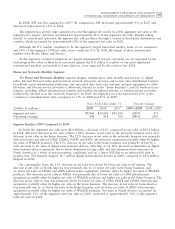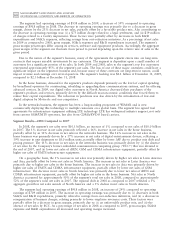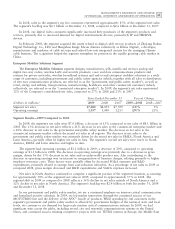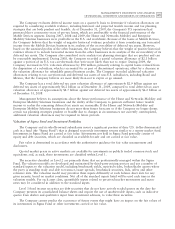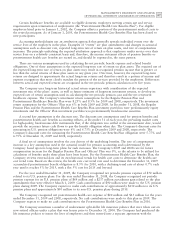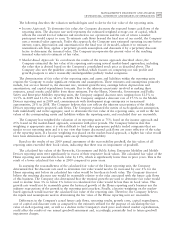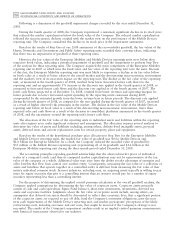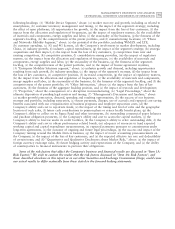Motorola 2009 Annual Report Download - page 76
Download and view the complete annual report
Please find page 76 of the 2009 Motorola annual report below. You can navigate through the pages in the report by either clicking on the pages listed below, or by using the keyword search tool below to find specific information within the annual report.
68 MANAGEMENT’S DISCUSSION AND ANALYSIS
OF FINANCIAL CONDITION AND RESULTS OF OPERATIONS
employees that split the policy benefits between the Company and the employee. Motorola owns the policies,
controls all rights of ownership, and may terminate the insurance policies. To effect the split-dollar arrangement,
Motorola endorsed a portion of the death benefits to the employee and, upon the death of the employee, the
employee’s beneficiary typically receives the designated portion of the death benefit directly from the insurance
company and the Company receives the remainder of the death benefit. The Company adopted new accounting
guidance on Accounting for Deferred Compensation and Postretirement Benefit Aspects of Endorsement Split-
Dollar Life Insurance Arrangements’’ as of January 1, 2008. This guidance requires that a liability for the benefit
obligation be recorded because the promise of postretirement benefit has not been settled through the purchase of
an endorsement split-dollar life insurance arrangement. As a result of the adoption of this new guidance, the
Company recorded a liability representing the actuarial present value of the future death benefits as of the
employees’ expected retirement date of $45 million with the offset reflected as a cumulative-effect adjustment to
January 1, 2008 Retained earnings and Accumulated other comprehensive income (loss) in the amounts of
$4 million and $41 million, respectively, in the Company’s consolidated statement of stockholders’ equity. It is
currently expected that minimal, if any, further cash payments will be required to fund these policies.
The net periodic pension cost for these split-dollar life insurance arrangements was $6 million for both the
years ended December 31, 2009 and 2008. The Company has recorded a liability representing the actuarial
present value of the future death benefits as of the employees’ expected retirement date of $48 million and
$47 million as of December 31, 2009 and December 31, 2008, respectively.
Recent market conditions have resulted in an unusually high degree of volatility and increased the risks and
illiquidity associated with certain investments held by the pension plans, which could impact the value of
investments after the date of this filing. The Company’s measurement date of its plan assets and obligations is
December 31.
Valuation and Recoverability of Goodwill and Long-lived Assets
Goodwill: The Company tests the recorded amount of goodwill for recovery on an annual basis in the
fourth quarter of each fiscal year. Goodwill is tested more frequently if indicators of impairment exist. The
Company continually assesses whether any indicators of impairment exist, which requires a significant amount of
judgment. Such indicators may include: a sustained significant decline in our share price and market
capitalization; a decline in our expected future cash flows; a significant adverse change in legal factors or in the
business climate; unanticipated competition; the testing for recoverability of a significant asset group within a
reporting unit; or slower growth rates, among others. Any adverse change in these factors could have a significant
impact on the recoverability of these assets and could have a material impact on our consolidated financial
statements.
The goodwill impairment test is performed at the reporting unit level. A reporting unit is an operating
segment or one level below an operating segment (referred to as a ‘‘component’’). A component of an operating
segment is a reporting unit if the component constitutes a business for which discrete financial information is
available and segment management regularly reviews the operating results of that component. When two or more
components of an operating segment have similar economic characteristics, the components shall be aggregated
and deemed a single reporting unit. An operating segment shall be deemed to be a reporting unit if all of its
components are similar, if none of its components is a reporting unit, or if the segment comprises only a single
component. As such, the Company has determined that the Mobile Devices segment meets the requirement of a
reporting unit. For the Enterprise Mobility Solutions segment, the Company has identified two reporting units,
the Government and Public Safety reporting unit and the Enterprise Mobility reporting unit. For the Home and
Networks Mobility segment, the Company has identified two reporting units, the Home reporting unit and the
Networks reporting unit.
The goodwill impairment test is a two step analysis. In Step One, the fair value of each reporting unit is
compared to its book value. Management must apply judgment in determining the estimated fair value of these
reporting units. Fair value is determined using a combination of present value techniques and quoted market
prices of comparable businesses. If the fair value of the reporting unit exceeds its book value, goodwill is not
deemed to be impaired for that reporting unit, and no further testing would be necessary. If the fair value of the
reporting unit is less than its book value, the Company performs Step Two. Step Two uses the calculated fair
value of the reporting unit to perform a hypothetical purchase price allocation to the fair value of the assets and
liabilities of the reporting unit. The difference between the fair value of the reporting unit calculated in Step One
and the fair value of the underlying assets and liabilities of the reporting unit is the implied fair value of the
reporting unit’s goodwill. A charge is recorded in the financial statements if the carrying value of the reporting
unit’s goodwill is greater than its implied fair value.



